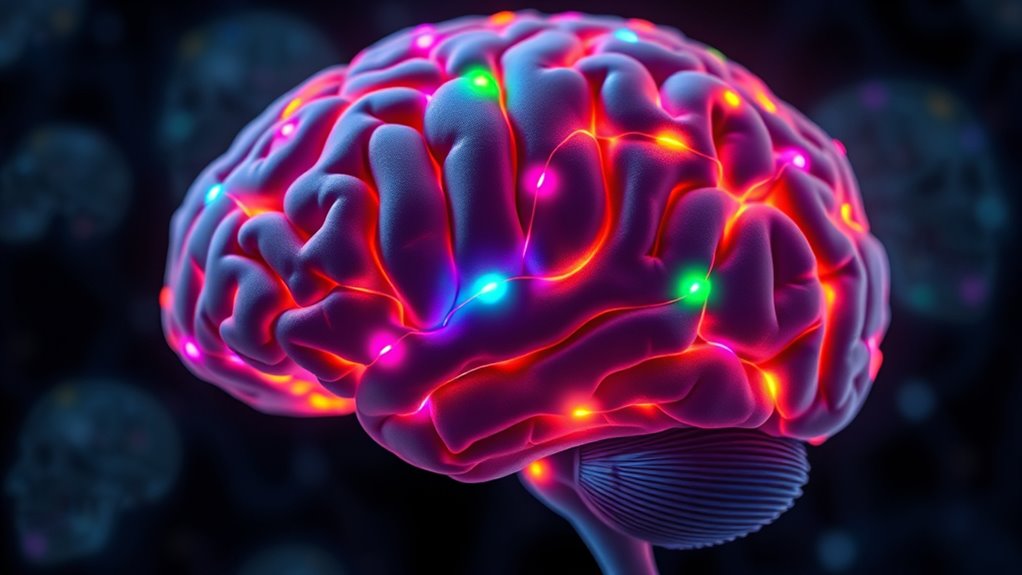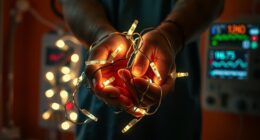Neuroplasticity is your brain’s ability to reorganize itself by forming new connections, especially after a stroke. When parts of your brain are damaged, your brain can reassign functions to undamaged areas, helping you recover skills like movement, speech, and thinking. This process is supported by targeted therapies, healthy habits, and persistence. If you keep exploring, you’ll discover how specific strategies and success stories can inspire your healing journey.
Key Takeaways
- The brain adapts by forming new neural connections through neuroplasticity, especially after stroke injury.
- Rewiring involves strengthening existing pathways and creating new connections in undamaged brain regions.
- Targeted therapies like physical, speech, and cognitive exercises stimulate brain reorganization and functional recovery.
- Neural mechanisms such as synaptic plasticity, axonal sprouting, and neurogenesis support brain rewiring.
- Factors like early intervention, repetition, and a healthy lifestyle enhance the brain’s ability to rewire post-stroke.
Understanding Neuroplasticity and Its Role in Recovery
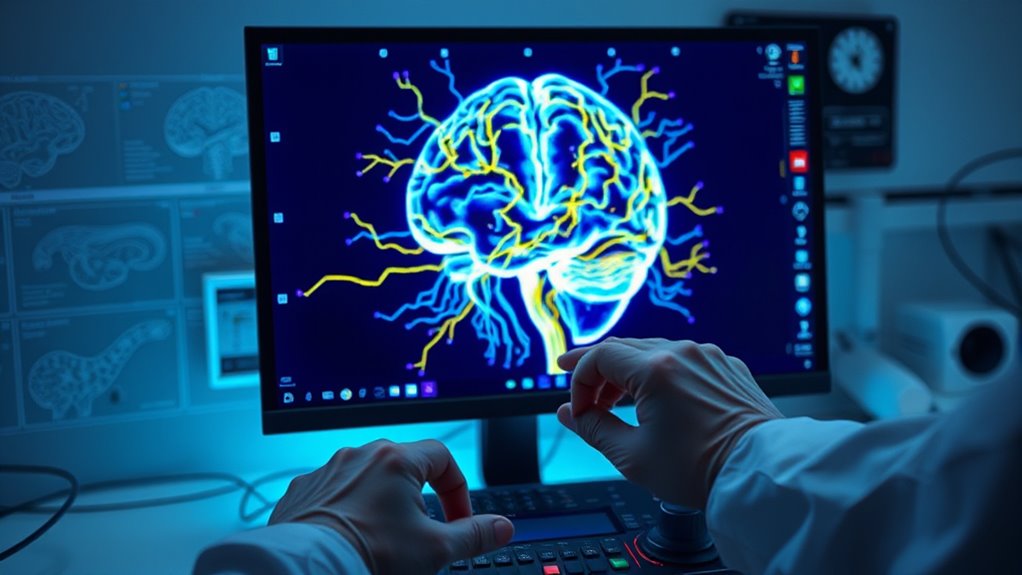
Neuroplasticity refers to the brain’s remarkable ability to reorganize itself by forming new neural connections throughout life. This means your brain can adapt, learn new skills, and recover from injuries like a stroke. When you experience a stroke, some areas of your brain may become damaged, but neuroplasticity allows other parts to take over those functions. Your brain rewires itself by strengthening existing connections and creating new pathways, which is essential for recovery. Engaging in targeted activities, therapy, and practice helps stimulate this process. Understanding this ability empowers you to participate actively in your rehabilitation. Additionally, brain adaptability demonstrates that recovery is possible, and your brain’s flexibility plays a pivotal role in regaining lost skills and improving overall function. The process of neuroplasticity is facilitated by neural connections that are strengthened through consistent effort, making rehabilitation more effective. Neuroplasticity shows that recovery is possible, and your brain’s flexibility plays a pivotal role in regaining lost skills and improving overall function. Recognizing the role of synaptic plasticity emphasizes how the connections between neurons are modified during recovery, further supporting rehabilitation strategies. Moreover, recent research indicates that activity-dependent plasticity can accelerate the rebuilding of neural networks during specific therapeutic interventions.
How Stroke Impacts Brain Function and Structure
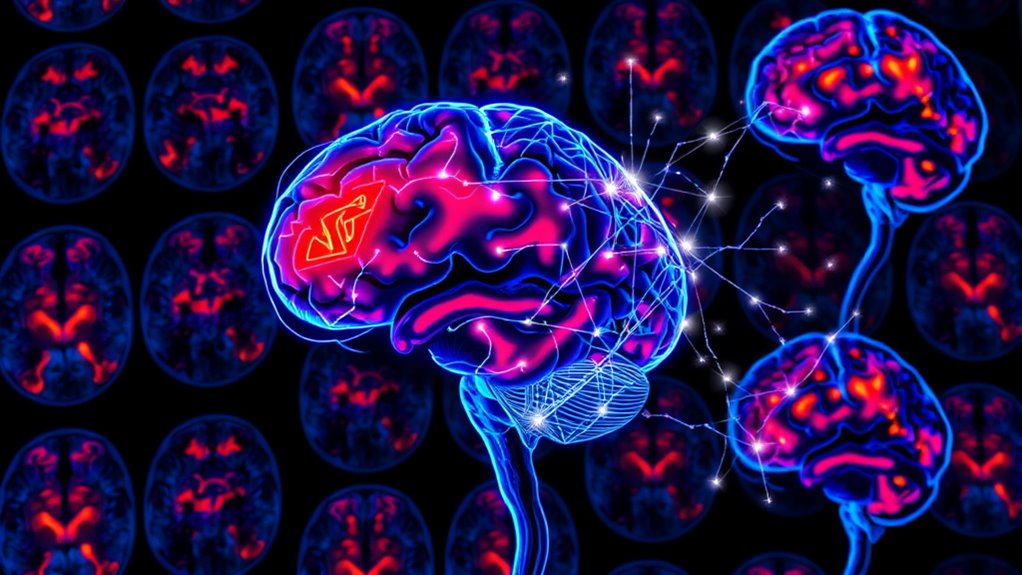
When a stroke occurs, it damages specific areas of your brain, affecting the functions they control. This disruption interrupts neural pathways, making communication between regions more difficult. As a result, your cognitive abilities and everyday skills can change profoundly. Neuroplasticity allows the brain to adapt and reorganize itself in response to such injuries, facilitating recovery processes.
Brain Area Damage
A stroke occurs when blood flow to a part of the brain is interrupted, causing brain cells to die and leading to damage in the affected area. This damage can impair specific functions depending on the region involved. For example, if the stroke hits the motor cortex, you might experience weakness or paralysis on one side of your body. Damage to language areas, like Broca’s or Wernicke’s, can lead to speech and comprehension difficulties. The extent of the damage depends on how much brain tissue is affected and how quickly you receive treatment. Over time, the injured brain tissue may shrink or change shape as part of the healing process. Recognizing which areas are impacted helps tailor your recovery and rehabilitation strategies.
Neural Pathway Disruption
Stroke disrupts the brain’s neural pathways, interrupting communication between regions and impairing function. When a stroke occurs, it damages the connections that transmit signals, leading to sudden deficits in movement, sensation, or speech. These disruptions can cause the brain to struggle with coordinating tasks it once performed effortlessly. The table below highlights common effects:
| Neural Pathway Disruption | Resulting Impairment |
|---|---|
| Motor pathways | Weakness, paralysis |
| Sensory pathways | Loss of sensation |
| Language pathways | Aphasia, speech difficulty |
| Visual pathways | Vision loss or disturbances |
| Coordination pathways | Balance and movement issues |
Understanding this disruption helps you grasp why rehabilitation focuses on rewiring these damaged connections.
Cognitive Function Changes
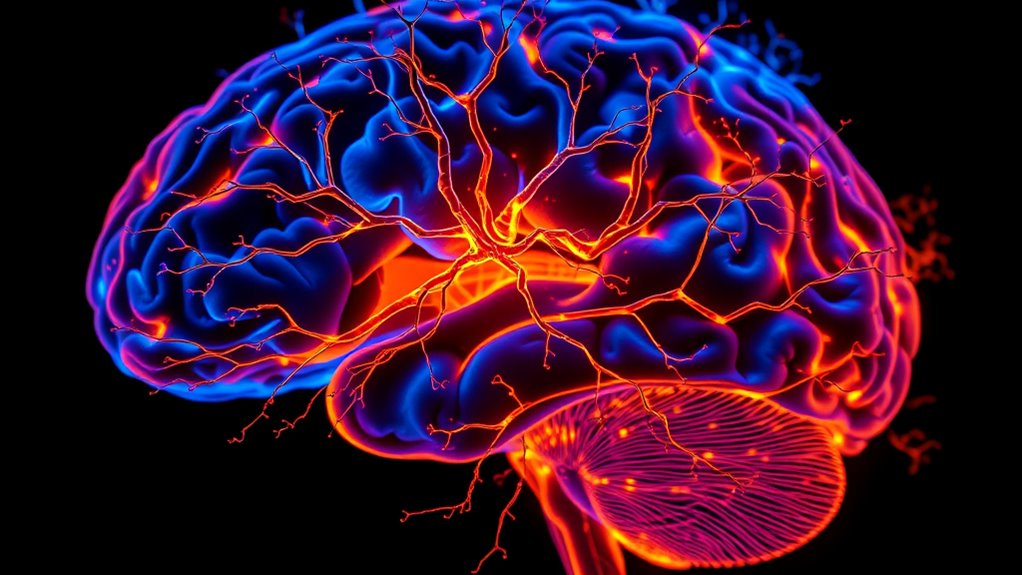
Neural pathway disruptions caused by stroke don’t just affect physical abilities—they also lead to significant changes in cognitive functions. You might notice problems with memory, attention, or problem-solving. Tasks that once felt simple may become challenging or confusing. Stroke can impair processing speed, making it harder to think clearly or respond quickly. Language skills might decline, affecting your ability to speak or understand others. These cognitive changes vary depending on the area of the brain impacted and the stroke’s severity. It’s important to understand that your brain can adapt over time, and neuroplasticityoffers hope for recovery. Targeted therapies and mental exercises can help rebuild these functions, enabling you to regain independence and improve your quality of life.
The Mechanisms Behind Brain Rewiring
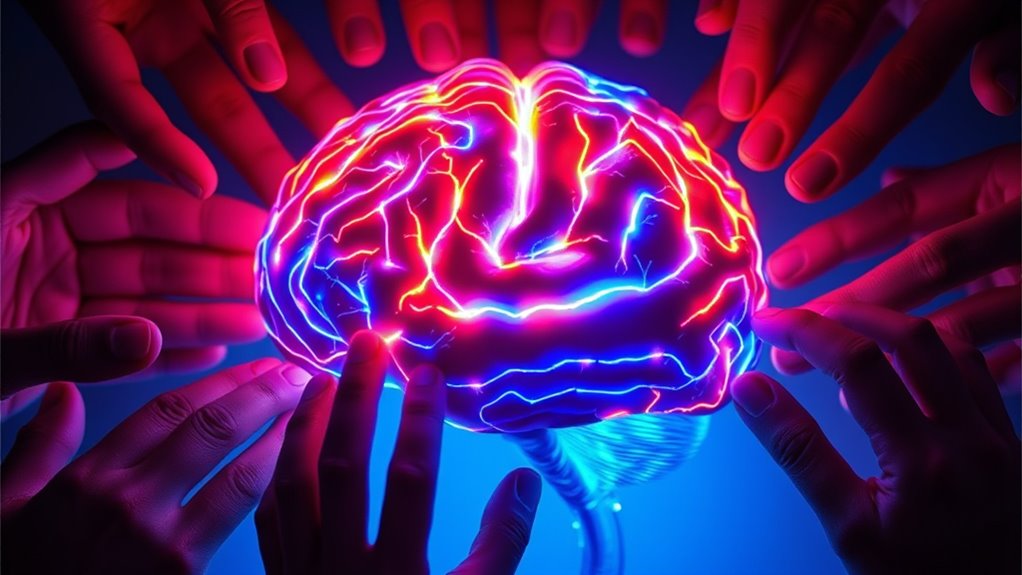
Understanding how the brain rewires itself requires examining the mechanisms that enable neuroplasticity. When you experience a stroke, your brain activates several processes to adapt. Synaptic plasticity is key; it involves strengthening or weakening connections between neurons based on activity levels. New neural connections form as the brain recruits nearby or even distant regions to compensate for damaged areas. Additionally, neurogenesis, or the growth of new neurons, can occur in specific regions, helping restore lost functions. Changes in neurotransmitter levels also influence rewiring, making neurons more or less likely to fire together. These mechanisms work together, allowing your brain to reorganize and establish new pathways, ultimately supporting recovery and functional improvement after a stroke. Neuroplasticity is a remarkable process that highlights the brain’s ability to adapt and heal itself through various interconnected mechanisms. Moreover, targeted therapies and exercises can facilitate brain rewiring by promoting these natural processes, which are supported by the brain’s inherent capacity for adaptation.
Factors That Enhance Neuroplasticity Post-Stroke
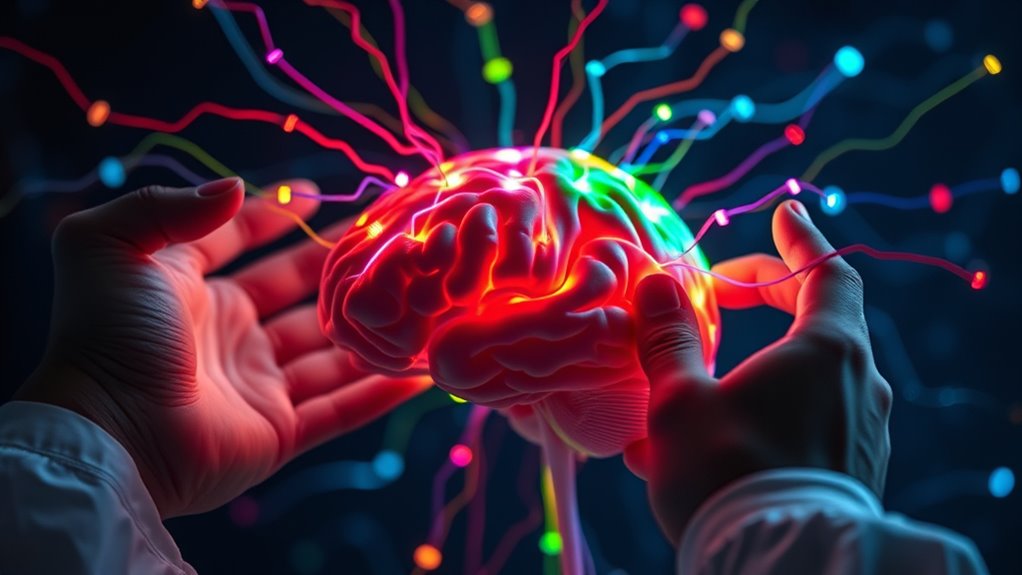
Several factors can substantially boost neuroplasticity after a stroke, aiding your brain’s recovery process. Engaging in physical activity stimulates blood flow and encourages the growth of new neural connections. Maintaining a balanced diet rich in nutrients like omega-3 fatty acids and antioxidants supports brain health and repair. Adequate sleep is essential, as it allows your brain to consolidate learning and repair damaged cells. Managing stress through mindfulness or relaxation techniques reduces cortisol levels that can hinder neuroplasticity. Social interactions and emotional support foster motivation and engagement, which are indispensable for recovery. Additionally, avoiding alcohol and drugs prevents interference with brain healing processes. By focusing on these factors, you create an environment conducive to brain rewiring and prime recovery after a stroke. Supporting data analysis can also help tailor personalized rehabilitation strategies, maximizing recovery potential. Incorporating positive vibrational energy techniques can further enhance your brain’s capacity to adapt and heal. Engaging in targeted cognitive exercises can further stimulate neural pathways and improve functional outcomes. Furthermore, understanding neuroplasticity mechanisms provides deeper insight into optimizing recovery strategies. Recognizing the role of brain chemistry in neuroplasticity can help in developing effective therapeutic interventions.
Therapeutic Strategies to Promote Brain Reorganization
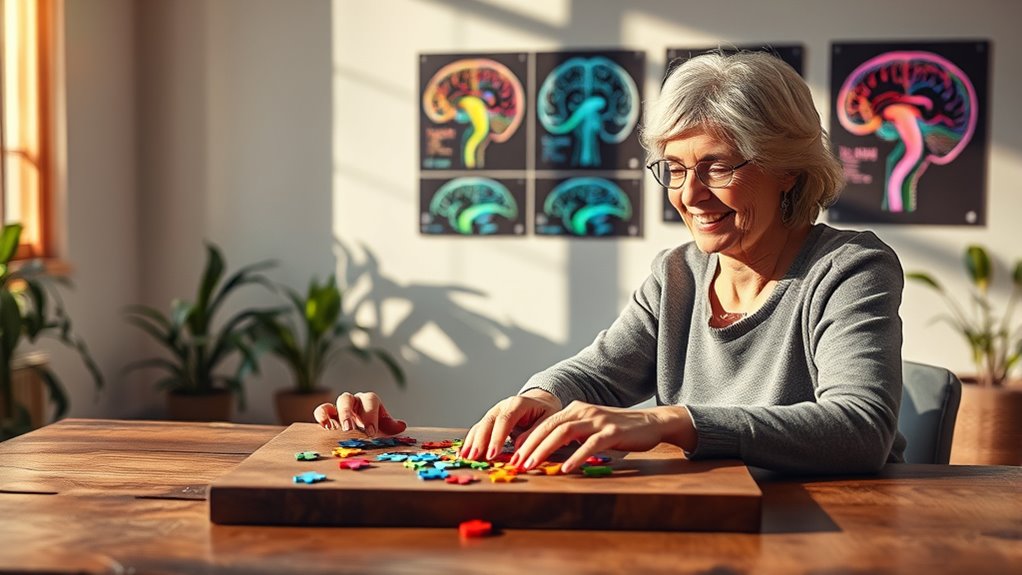
Therapeutic strategies play an essential role in guiding your brain’s reorganization after a stroke. Engaging in targeted physical, occupational, and speech therapies helps stimulate neural pathways and encourages new connections. Repetitive task practice reinforces learning and promotes functional recovery. Technologies like neurofeedback, transcranial magnetic stimulation (TMS), and virtual reality offer innovative ways to enhance neuroplasticity by activating specific brain regions. Combining these approaches with medication or supplements can further optimize outcomes. It’s imperative to stay motivated and consistent, as early and intensive therapy maximizes your brain’s ability to rewire itself. Remember, your active participation and perseverance greatly influence the success of these strategies, helping you regain independence and improve quality of life after stroke. Additionally, understanding dog names can be a fun way to stay engaged and motivated during the recovery process. Exploring neural pathways can help you better understand how targeted interventions facilitate brain rewiring.
Real-Life Success Stories of Brain Rewiring
Many people face initial challenges when rewiring their brains, but they find ways to overcome them. Innovative therapy techniques often play a vital role in transforming setbacks into progress. These inspiring stories demonstrate how determination and new methods can lead to remarkable personal change. Additionally, understanding the brain’s neuroplasticity can empower individuals to harness its ability to adapt and recover effectively. Recognizing the importance of therapy schedules can further optimize recovery outcomes for stroke survivors. For example, utilizing a free online tool for capitalization can help in creating clear and effective communication, which is vital in therapy sessions. As interest in alternative investments like gold IRAs increases, more resources are becoming available to support diverse recovery strategies. Recognizing how dream symbols reflect subconscious processes can also contribute to holistic approaches in mental and physical rehabilitation.
Overcoming Initial Challenges
Although rewiring the brain can seem formidable at first, countless individuals have successfully overcome initial obstacles through perseverance and targeted strategies. Your progress often depends on staying committed and adapting your approach. Many have faced setbacks but pushed forward with small, manageable goals. Recognize that recovery isn’t linear—patience is key. To help you overcome early challenges, consider these strategies:
- Set realistic, achievable milestones
- Celebrate small victories to stay motivated
- Maintain a daily routine for consistency
- Seek support from therapists or support groups
- Track your progress to see improvements over time
Innovative Therapy Techniques
Building on your perseverance through initial challenges, exploring innovative therapy techniques can further accelerate your brain rewiring journey. Techniques like virtual reality, robotics, and brain-computer interfaces are transforming recovery. Virtual reality immerses you in engaging environments, helping retrain motor skills and improve coordination. Robotics assist with repetitive movements, increasing precision and motivation. Brain-computer interfaces connect your brain activity directly to devices, enabling control of limbs or communication tools, fostering neuroplasticity. Many stroke survivors have experienced remarkable progress using these approaches, regaining speech, mobility, and independence faster than traditional methods. By embracing these cutting-edge therapies, you tap into your brain’s remarkable ability to adapt and rewire, turning recovery into an active and empowering process. The possibilities for your continued growth are more promising than ever.
Inspiring Personal Transformations
Real-life stories of brain rewiring demonstrate that remarkable recoveries are possible even after severe injuries. You see patients who, with determination and therapy, regain speech, mobility, and independence. These transformations showcase neuroplasticity’s power in action.
Consider these inspiring examples:
- A stroke survivor learning to walk again through targeted exercises
- An individual restoring language skills after aphasia
- Someone regaining fine motor control with repetitive practice
- A person overcoming visual deficits via specialized training
- A patient re-learning daily tasks with assistive technology
These stories prove that your brain can adapt and heal. With patience, perseverance, and proper support, you can liberate your brain’s potential and rewrite your recovery story. Neuroplasticity isn’t just theory—it’s a real pathway to hope.
Frequently Asked Questions
Can Neuroplasticity Occur at Any Age After a Stroke?
You might wonder if neuroplasticity can happen at any age after a stroke. The good news is, yes, it can. Your brain’s ability to rewire itself remains throughout your life, though it may be more flexible in younger years. With therapy and effort, you can promote brain changes at any age, helping you recover lost skills and regain independence. Your commitment and proper treatment make a significant difference.
How Long Does Brain Rewiring Typically Take Post-Stroke?
Imagine your brain setting out on a wild, unstoppable journey of rewiring after a stroke. Typically, most of this brain reorganization happens within the first three to six months, but some changes can continue for years. Every person’s recovery speeds are unique—so don’t be discouraged if it takes longer. With persistent effort, your brain can adapt and regain functions, making that rewiring process an incredible, ongoing adventure.
Are There Risks Associated With Promoting Neuroplasticity?
You might wonder if encouraging neuroplasticity has risks. While promoting brain rewiring can aid recovery, it can sometimes lead to maladaptive changes, like developing pain or abnormal movements. Overexerting yourself or forcing recovery too quickly may cause frustration or injury. It is crucial to work closely with healthcare professionals who can guide your activities safely, ensuring neuroplasticity benefits you without unnecessary risks.
Does Neuroplasticity Guarantee Full Recovery?
Think of your brain like a garden; neuroplasticity is the process of planting new pathways. While this can lead to impressive growth, it doesn’t guarantee full recovery—sometimes weeds or pests (limitations or setbacks) get in the way. Studies show that early and consistent therapy improves outcomes, but individual results vary. So, with effort and patience, you can often maximize recovery, even if it’s not always complete.
How Can Caregivers Support Brain Rewiring Efforts?
You can support brain rewiring efforts by encouraging your loved one to practice targeted exercises regularly and stay engaged in activities that challenge their skills. Offer patience and positive reinforcement to boost motivation. Make sure they follow their therapy plan and stay consistent. Creating a supportive environment, reducing stress, and promoting healthy habits like proper sleep and nutrition also help optimize the brain’s ability to rewire and recover after a stroke.
Conclusion
Imagine your brain as a resilient network that can adapt and rewire itself after a stroke. While some believe neuroplasticity is limited, evidence shows your brain’s capacity to reorganize is remarkable, especially with the right therapy and mindset. Embrace the possibility that, with persistence and support, your brain can form new pathways, restoring functions you thought were lost. Trust in its incredible ability to heal and rebuild—your journey to recovery is more hopeful than you might think.
